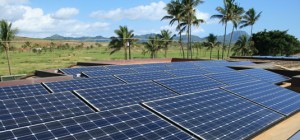 Another Aloha Friday from our friends in Hawaii, where record-setting rooftop solar deployment on the island of Molokai is leading to an avoidable and largely policy-made crisis. As the Molokai Dispatch reports:
Another Aloha Friday from our friends in Hawaii, where record-setting rooftop solar deployment on the island of Molokai is leading to an avoidable and largely policy-made crisis. As the Molokai Dispatch reports:
As of last March, 65 solar applications on Molokai were in limbo, following an effective shut-down of Maui Electric to accept additional rooftop solar systems onto the island’s grid. At 51 percent as of last year, Molokai has the highest percentage in Hawaii of rooftop solar compared to the island’s peak electricity demand. Most of the rooftop solar is installed under a program called Net Energy Metering (NEM), which pays customers the retail electric rate for excess energy generated from their panels. Maui Electric asked the PUC to close that program, and their request is still being reviewed.
During a meeting on Molokai in March 2015, Mat McNeff, MECO manager of engineering, told residents because the high volume of solar generation on Molokai could cause fluctuations in electric frequency resulting in potential island-wide power outages, MECO is no longer able to connect new rooftop photovoltaic (PV) systems under the NEM program.
I’m sympathetic to the challenges that this level of solar penetration can cause for grid operators. But there should be a logical and immediate policy response to address the challenges.
First, the utility needs to get permission immediately to revise electricity rates to encourage as much usage as possible during peak solar hours. State regulators should require these time-of-use rates to get island residents to shift as much discretionary usage to mid-day hours and away from night time as possible. I recognize there may be some equity impacts for those unable to shift their usage, but think of the equity impacts right now from holding up all of these solar applications.
Second, state regulators need to develop an immediate incentive program for those with solar applications to also purchase on-site energy storage. Home batteries could help moderate the output from this rooftop energy and provide electricity after the sun goes down. This would greatly help grid operators deal with the frequency fluctuation and avoid having to ramp up other resources quickly around sunset.
While it’s a bit unfair to require this only of new solar customers, it’s a long-term and unavoidable need and better than letting them languish. Plus the incentives could also target existing solar customers.
To be sure, these policy responses aren’t exactly new ideas. They are commonly discussed throughout the U.S. and other places with strong solar policies as long-term needs to deal with increasing solar uptake. But the island of Molokai is experiencing a solar crisis right now, and it’s small enough to implement these ideas quickly and see how they play out.
I hope the utility and state regulators can move quickly to address this problem. The rest of the world will certainly be watching.
Leave a Reply
You must be logged in to post a comment.


